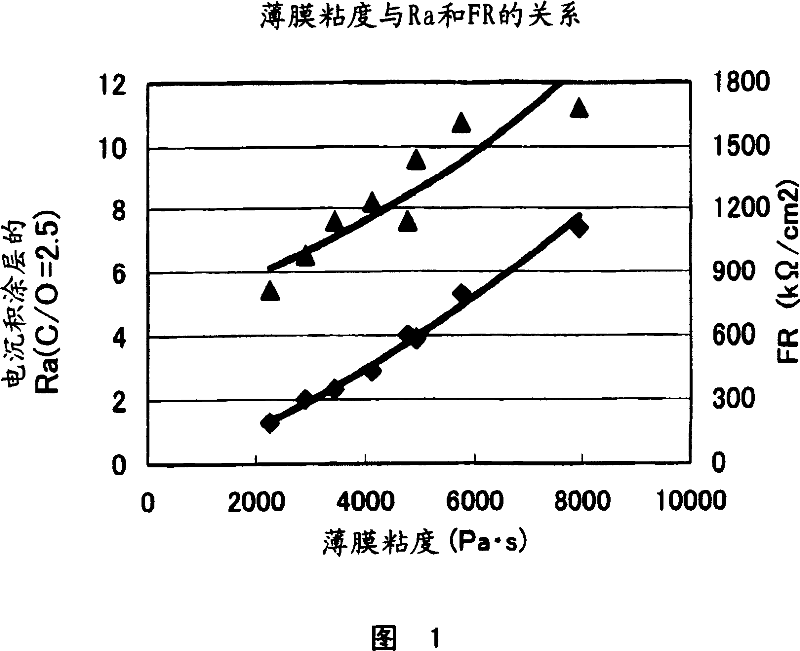Method for forming electrodeposited coating
A technology of electrodeposition and cationic electrodeposition, which is applied in the direction of coating, electrolytic coating, electrolytic inorganic material coating, etc., can solve the problem that the coating cannot be smoothed by electrodeposition
- Summary
- Abstract
- Description
- Claims
- Application Information
AI Technical Summary
Problems solved by technology
Method used
Image
Examples
preparation example Construction
[0046] Preparation of Cationic Electrodeposition Coating Composition
[0047] The cationic electrodeposition coating composition of the present invention can be prepared by dispersing the above-mentioned cationic epoxy resin, blocked isocyanate curing agent, and if necessary, pigment dispersion slurry and catalyst in an aqueous medium. Typically, the aqueous medium contains a neutralizing acid to neutralize the cationic epoxy resin to improve dispersibility. Examples of neutralizing acids include inorganic acids and organic acids such as hydrochloric acid, nitric acid, phosphoric acid, formic acid, acetic acid, lactic acid, sulfamic acid and N-acetylglycine. The aqueous medium in this specification is water or a mixture of water and an organic solvent. Ion-exchanged water is preferably used as water. Examples of usable organic compounds include: hydrocarbons such as xylene and toluene; alcohols such as methanol, n-butanol, isopropanol, 2-ethylhexanol, ethylene glycol, and pr...
preparation Embodiment 1-1
[0067] Preparation Example 1-1 Preparation of Blocked Isocyanate Curing Agent
[0068] Weigh 199 parts of trimer of hexamethylene diisocyanate (manufactured by Nihon Polyurethane Industry Co., Ltd., trade name COLONATE HX), 32 parts of methyl isobutyl ketone (MIBK) and 0.03 part of dibutyl dilaurate Tin into a flask equipped with a stirrer, cooler, nitrogen injection tube, thermometer and dropping funnel, add 87.0 parts of methyl ethyl ketone oxime dropwise from the dropping funnel to the mixture within 1 hour while stirring and blowing with nitrogen bubbly. The temperature was raised from 50°C to 70°C. After that, the reaction was continued for 1 hour until the absorption of the NCO group in the infrared spectrometer disappeared. After that, 0.74 parts of n-butanol and 39.93 parts of MIBK were added to adjust the non-volatile content to 80%.
preparation Embodiment 1-2
[0069] Preparation Example 1-2 Preparation of Blocked Isocyanate Curing Agent
[0070] Weigh 125 parts of diphenylmethane diisocyanate and 26.6 parts of MIBK into a flask equipped with a stirrer, cooler, nitrogen injection tube, thermometer and dropping funnel, and after heating the mixture to 80 °C, add 0.25 parts of dilauric acid diisocyanate Ding Xi. A solution obtained by dissolving 22.6 parts of ε-caprolactam in 94.4 parts of butyl cellosolve was dropped into the mixture from the dropping funnel over 2 hours at 80°C. After the mixture was further heated at 100° C. for 4 hours, the reaction was continued until the absorption of the NCO group disappeared in the infrared spectrometer. After standing and cooling, 33.6 parts of MIBK were added to adjust the non-volatile content to 80%.
PUM
| Property | Measurement | Unit |
|---|---|---|
| thickness | aaaaa | aaaaa |
| thickness | aaaaa | aaaaa |
Abstract
Description
Claims
Application Information
 Login to View More
Login to View More - R&D
- Intellectual Property
- Life Sciences
- Materials
- Tech Scout
- Unparalleled Data Quality
- Higher Quality Content
- 60% Fewer Hallucinations
Browse by: Latest US Patents, China's latest patents, Technical Efficacy Thesaurus, Application Domain, Technology Topic, Popular Technical Reports.
© 2025 PatSnap. All rights reserved.Legal|Privacy policy|Modern Slavery Act Transparency Statement|Sitemap|About US| Contact US: help@patsnap.com


